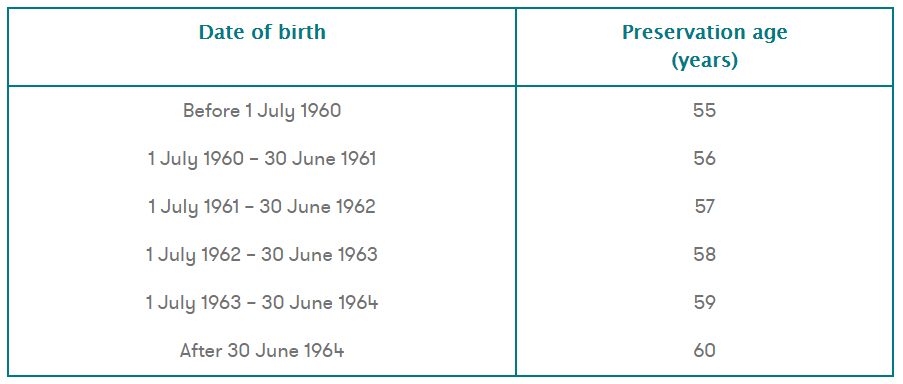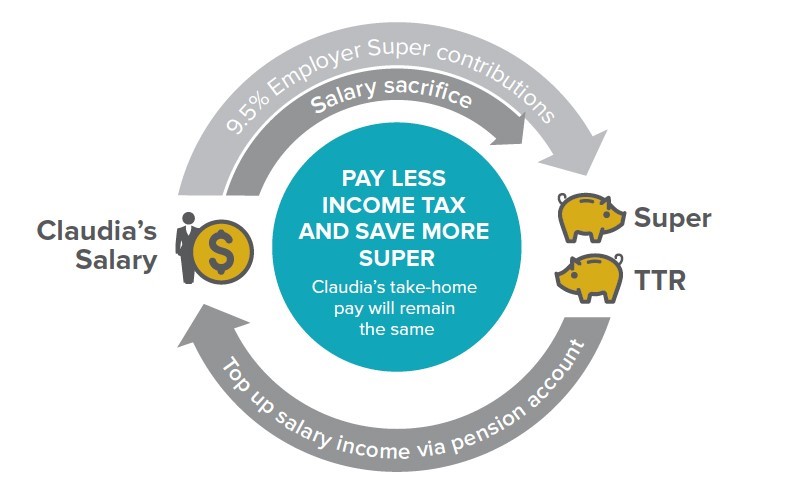Under the current rules, if you reach your ‘superannuation preservation age’ (between 55 and 60, depending on when you were born), you can periodically withdraw money from your super while continuing to work full-time, part-time or casually. Previously, you could only access your super once you turned 65 or retired.
This is known as ‘transaction to retirement’ (TTR). Below we provide details about how it works.
What is a TTR Strategy
A ‘transition to retirement’ (TTR) is a retirement strategy that you can use to gradually move into this new phase of your life. It is a type of pension that enables you to access an income from your super, even if you’re still working and receiving a contribution from your employer or business.
To access your super this way, you must have reached the preservation age (see Figure 1).
Figure 1. Preservation age.
Source: Canstar (2018)
Starting a TTR pension
To start a TTR pension you have to transfer some of your super accumulation account to a super account-based pension. As you are still working, you need to leave at least a small balance in your accumulation account so that it remains open to receive ongoing employer super contributions and any voluntary contributions you make.
Your TTR pension can be rolled back into your super accumulation account at any time. This means that if you do start a transition to retirement pension but no longer need the income, you can stop the pension at any time and simply go back to accumulating your super.
Limits
There are limits to consider related to how much of your super you can access, and these are:
- A minimum TTR income stream of 4% and maximum of 10% of the pension account balance each financial year,
- You cannot withdraw a lump sum.
Ways to use TTR
There are three ways you could use this income:
- To reduce work hours (you decide to move into part-time work)
- To increase your income while continuing to work the same number of hours.
- To contribute more to super -via a salary sacrifice arrangement-, so you can boost your super balance without reducing your take home pay.
Pros and Cons
Pros
Source: Legal Super
- Supplement your income.
A transition to retirement pension can help you supplement your income if you want to reduce your working hours.
- Boost your super savings.
As you continue working, you will continue to receive employer contributions to your super which will help balance out the amount you take out in pension payments, meaning your savings can keep growing.
You can further boost your super savings if you salary sacrifice some of your earned income to super. This is because contributions made to super are generally taxed at 15% whereas income received as salary or wages is taxed at your marginal rate which can be up to 47% (including medicare levy).
- Save on tax
The income you receive from a TTR pension is more favourably taxed compared to your earned income. If you are between 55 and 59, the taxable amount of your income from a TTR pension is taxed at your personal income tax rate, but also attract a 15% tax offset. Then, once you turn 60, the income you receive from your TTR pension is completely tax-free.
Plus, by salary sacrificing some of your pay to super you will also reduce your taxable income.
Cons
- Less money in retirement
You have to consider that the earlier you access your super, the less you may have in the long run, which could influence your lifestyle when you retire permanently.
- The benefits may not be worth all the trouble
This strategy works best if you are aged 60 or older and are a mid to upper middle income earner
Transition to retirement is a flexible option that allows you to work longer and retire later and rewards you for staying in the workforce. A TTR pension can still be worth considering for someone close to retirement age wanting to scale back their work hours while minimising the drop in their income.
References
[1] AMP (2017), How do transition to retirement income streams work?, https://www.amp.com.au/news/2017/april/how-do-transition-to-retirement-income-streams-work
[2] ASIC’s Money Smart (2018), How Transitioning to Retirement Works, https://www.moneysmart.gov.au/superannuation-and-retirement/income-sources-in-retirement/income-from-super/transition-to-retirement
[3] Australian Taxation Office (2015), Transition to retirement, https://www.ato.gov.au/individuals/seniors-and-retirees/transition-to-retirement/
[4] Canstar (2018), How Transitioning to Retirement Works, https://www.canstar.com.au/superannuation/transitioning-retirement/
[5] Industry Super Funds (n.d.), Transition to retirement (TTR), https://www.industrysuper.com/retirement-info/transition-to-retirement-ttr/







